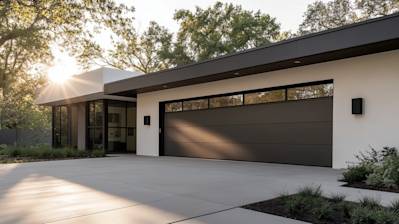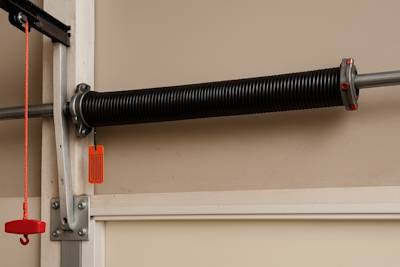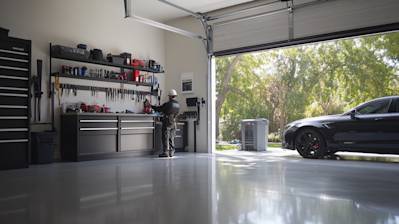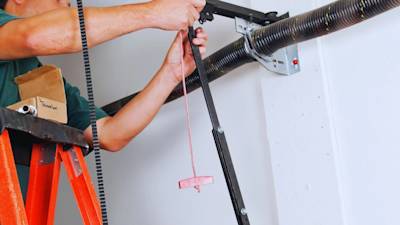Your garage door is a significant part of your house. It not only secures your vehicle and additional valuables but also contributes to the overall aesthetic appeal of your home. However, the proper functioning of your garage door hinges on one crucial element: garage door springs. This article provides an in-depth scrutiny of garage door springs, their roles, the different types, how to maintain them, and when to replace them.
What are Garage Door Springs?
Garage door springs play a pivotal role in the opening and closing of the garage door. They store mechanical energy when the door is closed and release it when the door is opened. This process offsets the weight of the door, making it possible either for an individual to lift it manually or for a garage door opener to function without being overloaded.
Key Roles of Garage Door Springs
Balance: The garage door springs' pivotal role is to balance the garage door. They counteract gravity, making it feel lighter and easier to maneuver. Without springs, your garage door would be virtually impossible to lift manually and would put excessive strain on the garage door opener.
Lift: The stored energy in the garage door springs provides most of the power needed to lift the garage door. If your springs are in good shape, lifting the door manually should require minimal effort.
Support: Lastly, these springs play a role in accommodating the door’s weight during closing. This guarantees a gentle and controlled descent.
Types of Garage Door Springs
Primarily, there are two types of garage door springs:
Extension Springs: Located along the horizontal tracks on both sides of the garage door, extension springs stretch and contract as the garage door moves, providing the necessary balance.
Torsion Springs: These are firmly installed above the garage door and twist as the door moves. Torsion springs are more durable and provide better balance than extension springs.
How Long Do Garage Door Springs Last?
The lifespan of a garage door spring largely depends on the usage, quality, and maintenance. Generally, a standard spring might last anywhere from 7-9 years with regular use. High-quality springs, on the other hand, might last for over a decade. However, springs tend to weaken with time, affecting the garage door’s efficiency and balance.
Recognizing Signs of Wear and Tear
How do you know when your garage door spring starts wearing out? Here are a few signs to look out for:
Unbalanced Door: The weight of the door is unevenly distributed, making the door sit crooked or fall rapidly when released.
Loud Noise: When springs break, they usually make a loud noise due to the quick release of tension.
Difficulty in Opening: If your garage door is not easy to lift, this could indicate a problem with the springs.
Maintenance Tips for Garage Door Springs
Improve the longevity and functionality of your garage door springs with these maintenance tips:
Regular Inspection: Inspect your garage door springs for any signs of wear and tear.
Lubrication: Annually apply garage-door specific lubricant to the springs to maintain their smooth operation.
Balanced Door Check: Ensure that your garage door is well balanced. If it gets unbalanced, call a professional to adjust the springs.
When To Replace Garage Door Springs
Replacing your garage door springs is vital when they break or when they've reached their lifespan limit, usually noticeable when the door becomes shaky, heavy, or opens and closes unevenly. Always when replacing, consider hiring a professional technician because the tension in the springs can make replacement dangerous for the inexperienced.
Frequently Asked Questions about Garage Door Springs
What Are the Types of Garage Door Springs?
Primarily, there are two types of garage door springs: torsion springs and extension springs. Torsion springs are located above the garage door and work by twisting to generate force. Extension springs, on the other hand, are located on either side of the garage door and extend when the door is closed to generate force.
How Long Do Garage Door Springs Last?
Generally, garage door springs are engineered to last between 10,000 and 20,000 cycles, depending on the type of spring and its quality. A cycle is defined as one operation of opening and closing the garage door. With average use, most springs last about 7-9 years.
How Can I Tell If My Garage Door Spring Is Broken?
A broken garage door spring can manifest in various ways, including a garage door that won't open, appears crooked, or opens and closes very rapidly. You may also hear a loud bang from the garage, as a garage door spring breaking can sound like a gunshot due to the sudden release of tension.
Can I Replace a Garage Door Spring Myself?
While it is technically possible to replace garage door springs yourself, it is not recommended unless you have the appropriate knowledge and tools. Improper handling of garage door springs can lead to serious injury due to the high tension they're under. It's typically safer and more effective to hire a professional garage door technician.
Can I Use My Garage Door with a Broken Spring?
You should not operate a garage door with a broken spring. The door could come crashing down at any moment which could be dangerous. In addition, the additional weight and stress placed on your garage door opener could cause it to break as well.
How Are Garage Door Springs Adjusted?
Garage door springs are adjusted by tightening or loosening the tension. This process is precise and dangerous, as there's a high risk of the spring breaking if done incorrectly. Therefore, it’s always best to seek professional help when dealing with spring adjustment.
How Much Does It Cost to Replace Garage Door Springs?
The cost to replace garage door springs varies based on factors such as labor, the specific type of spring, and the location of the job. On average, though, you can expect to pay between $100 and $200 for professional garage door spring replacement.
How Often Should Garage Door Springs Be Replaced?
Generally, garage door springs should be replaced as soon as they break. Waiting to replace a broken spring can lead to other issues, such as a bent or broken garage door, or a damaged garage door opener. Regular check-ups and maintenance can help detect any potential issues before they lead to a broken spring.
Pros of Garage Door Springs
Essential for Garage Door Operation
Garage door springs play a vital role in the operation of the garage door, making the door lighter as it goes up and down. Their tension counterbalances the weight of the door, allowing you to lift it up easily or reducing the load on the door opener. Without them, opening the garage door would be a stiff and strenuous task.
Different Types
There are two primary types of garage door springs: extension and torsion springs. This variety allows homeowners to choose the ones that fit their needs the best. Extension springs stretch along the garage door’s horizontal track, while torsion springs mount to the header above the garage door and wind up as the door closes. They have different strengths and weaknesses, which we'll delve into later.
Durability
Garage door springs are typically very durable and can last many years, often between 7 and 9 years, if they’re maintained well. High-quality variations, such as high-cycle torsion springs, can last even longer, spanning over 20,000 cycles.
Cost-Effective
While they play a critical role, garage door springs are not hugely expensive. The price can vary depending upon the type of spring and its quality, but in general, homeowners find them to be reasonably priced for the value they provide.
Cons of Garage Door Springs
Requires Regular Maintenance
Garage door springs require regular maintenance to ensure they continue to work correctly and safely. This routine upkeep might involve lubrication to prevent corrosion, inspection for wear and tear, and tension adjustments. If neglected, springs lose their effectiveness over time and could potentially break.
Potential Safety Hazards
A poorly maintained or broken spring can be a significant safety hazard. When a garage door spring snaps, it can shoot off like a missile, potentially causing injury to people or damage to property. Homes with children or pets need to be especially vigilant about spring maintenance to prevent accidents.
Difficult to Replace
Replacing garage door springs can be quite tricky and is not recommended as a DIY task for the average homeowner. The springs are under immense tension, and a mistake during replacement can lead to severe injury. Therefore, you often need to hire a professional for this task, adding to the expense and inconvenience.
Limitations Based on Type
Though having different types of springs (torsion and extension) provides choices, each comes with its limitations. Extension springs can be more prone to breakage as they stretch and contract with every use. Torsion springs, though more robust and safer, are sturdier and more costly.
Torsion Springs
Cons
Torsion springs are more expensive than extension springs, which may be a disadvantage for homeowners on a tight budget. They also require more headroom above the garage door, restricting their use in spaces with low ceilings.
Pros
On the plus side, torsion springs offer better balance, which makes the garage door easier to operate. They last longer and are safer because they stay on the shaft if they break, unlike extension springs which can whip around.
Extension Springs
Cons
Extension springs have a higher risk of causing harm if they break. Since they extend and contract, if a spring breaks without a safety cable, it could fly off and harm people or property. Also, they are not optimal for heavier doors, as they might not provide sufficient lifting power.
Pros
However, extension springs are usually cheaper and require less overhead space, making them a preferred choice for smaller garages. They also come in many sizes, allowing for a lot of flexibility in fitting different garage doors.
Summary
So, we've learned quite a bit about garage door springs today. They are essential components for any garage door system. These springs are responsible for helping to lift and lower the door, a weighty task that they expertly handle. A properly functioning spring can make a world of difference in how smoothly and efficiently your garage door operates.
That being said, when the garage door springs get damaged or worn out, it can cause serious problems. These problems can not only disrupt the smooth operation of your door but may also pose a threat to your safety. It's important to regularly check the condition of your springs and maintain them proactively, to keep your garage door operating in top shape.
Remember, when it comes to replacing or repairing garage door springs, it's always best to leave it to professionals. This task can be hazardous due to the high tension in the springs. Professionals are trained to handle these kinds of jobs. By allowing professionals to maintain your garage door springs, you can ensure the safety and longevity of your garage door system.
About 1A Garage Doors
1A Garage Doors is a family-owned and operated garage door company based right in the heart of Sacramento, CA. We've been serving the community and surrounding areas for over two decades, installing, repairing, and maintaining garage doors with dedication and passion. We take pride in offering exceptional service, using high-quality products, and ensuring our customer's satisfaction is always our top priority. There's a reason we're the premier choice for garage service doors in Sacramento—but don't just take our word for it, experience our service first-hand!








